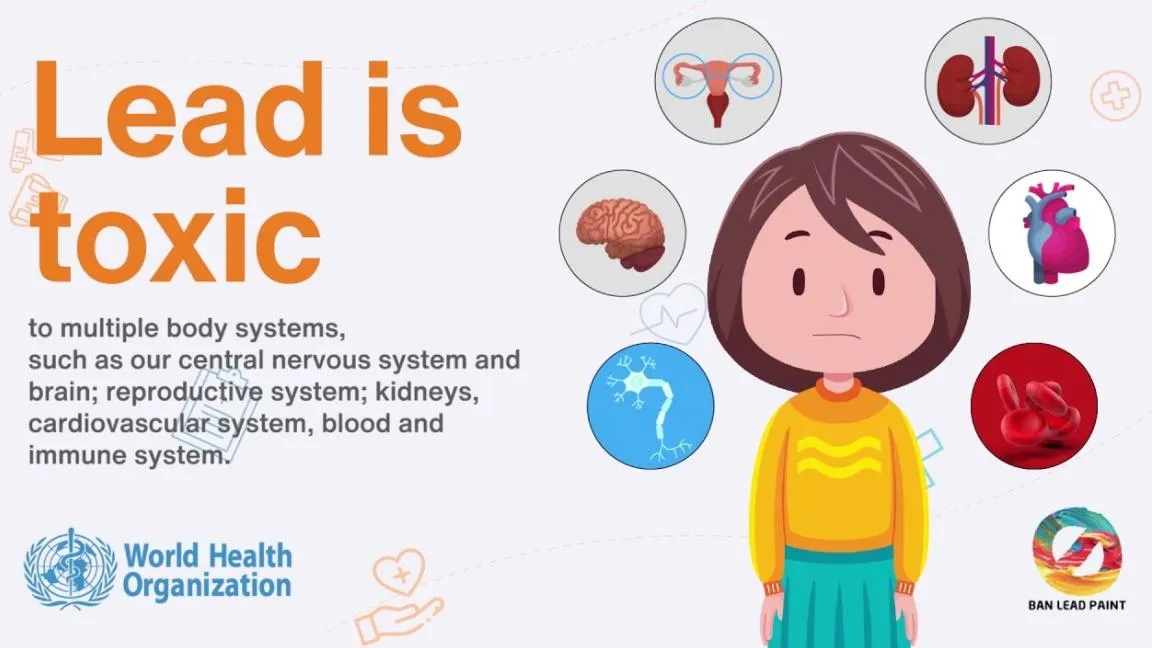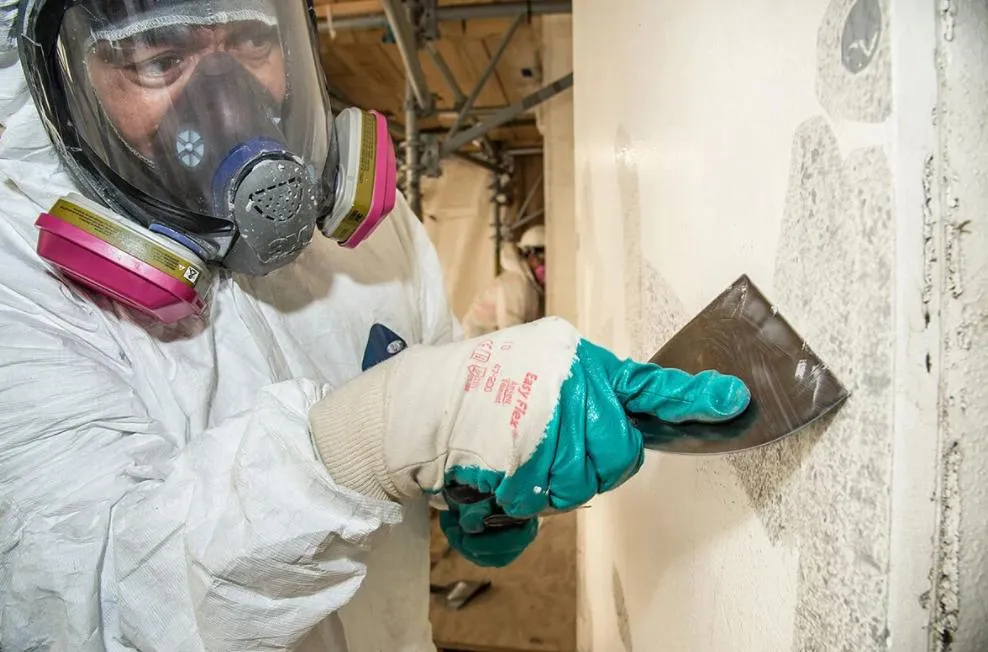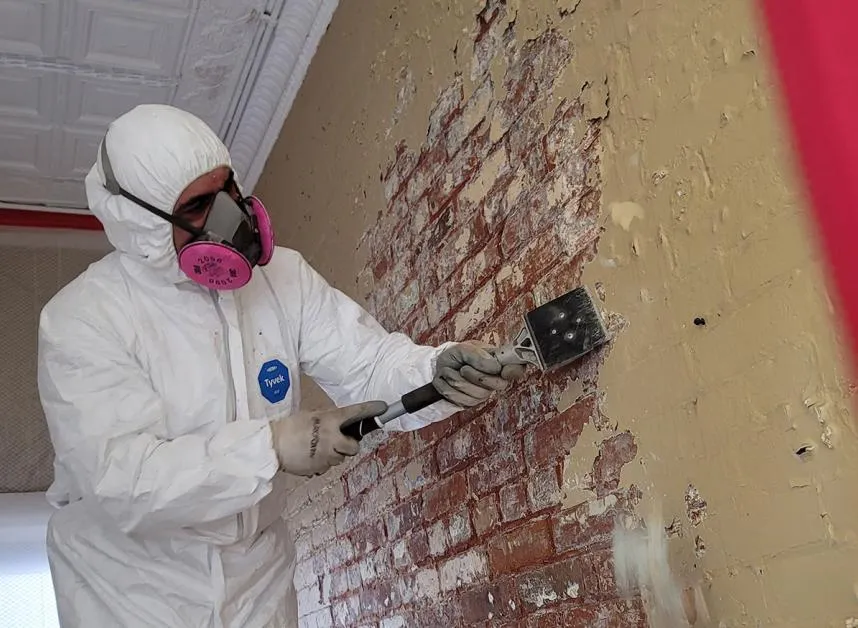Working around lead dust is risky, and proper protection is crucial. Choosing the right coverall suit for lead dust protection can make a big difference in your safety. In this guide, I share my experience on selecting coverall suits that block harmful particles, provide full coverage, and meet OSHA and EPA rules. I’ll explain the best materials, designs, and brands to keep you safe on jobs!
Understanding Lead Dust Hazards and Why I Recommend Coverall Suits
Lead dust is a dangerous particle that floats in the air. It gets released when you work with materials containing lead. I’ve seen this happen often in buildings built before 1978 and in many industrial jobs.
You can breathe in or swallow this dust without knowing it. The lead then enters your bloodstream. It can build up in your body’s tissues and stay there for years. Based on my experience, even a small amount of exposure adds up and becomes very dangerous over time.
Health Risks from Lead Dust Exposure
From what I’ve seen, the health risks are serious, and I suggest you pay close attention to them.
Children: For children, lead dust can cause permanent brain and nerve damage. This can lead to problems with thinking, hyperactivity, learning disabilities, and a lower IQ.
Adults: Adults may experience memory loss, headaches, and trouble concentrating. Other risks I’ve noted are slower motor skills, kidney problems, high blood pressure, anemia, and reproductive issues. Severe symptoms appear when blood lead levels exceed 70 μg/dL for children and 100 μg/dL for adults.
Respiratory Effects: Breathing in lead dust makes it hard to breathe and can damage your organs.
Long-term Risks: If you are exposed for a long time, your risk of muscle and joint pain increases. It also raises the risk of heart disease. Over 500,000 U.S. children under six have blood lead levels above the safety reference number.
High-Risk Work Environments
I believe you need to be extra careful if you work in certain industries. Jobs with high lead exposure include:
– Renovating and painting older homes
– Tearing down structures with lead-based paint
– Making or recycling batteries
– Construction, smelting, foundries, and plumbing with lead pipes or solder
In these jobs, I strongly recommend using protective coverall suits. They are a critical piece of personal protective equipment (PPE). These work sites must follow OSHA and EPA safety rules. Selecting the correct coveralls is very important. I suggest this because they help keep lead dust off your skin and stop you from carrying it to other areas, like your car or home.
How do I Pick the Best Coverall Suit for Lead Dust Safety?
From my experience, picking a coverall suit for lead dust protection means I have to check a few key features. This helps me make sure I’m safe and following all the rules.
Why the Right Coverall Suit Material is a Big Deal?
I recommend safety coverall suits made from professional-grade polypropylene. You can also use blends made for industrial work. Polypropylene is great because it is dust-resistant. It also resists punctures and tears well. The material is also breathable. This is important for comfort when I’m working on long jobs, like removing lead or renovating old buildings.
Design Features I Look For to Get Full Coverage
I suggest choosing full body coverall suits that have integrated hoods and boot covers built right in. This design gives you complete coverage. It stops lead dust from getting on your skin, hair, or clothes. I find that a secure fit is also key. It should be snug, but not so tight that you can’t move. This helps lower the risk of exposure. I always check the zippers and seams to make sure they are designed to keep dust out.
Meeting Safety Rules of Coverall Suits
You must make sure your coverall suit meets OSHA regulations. I also check my state’s safety codes, like §1910.133 and California’s Title 8, Section 1532.1, for lead. The rules say workers need full-body work clothing if lead exposure is above the permissible exposure limit (PEL). This is true even if you are already wearing a respirator.
How to Handle Used Coveralls Safely?
Employers need to give you clean, dry coveralls at least weekly. If airborne lead is high (over 200 µg/m³ by OSHA or 30 µg/m³ in CA), you should get a new one daily. I put used coveralls in closed, protective containers. This keeps the lead dust from spreading. Never clean or shake the coveralls to get dust off. Based on my experience, this creates a serious hazard.
Sizing, Packing, and Keeping Stock
Disposable coverall suits come in many sizes, from S to XXL. This ensures every team member has a comfortable and proper fit. I find that buying in bulk is easier. Cases often have 25 suits. The box size is usually 24″ x 18″ x 12″, which makes them easy to store and hand out on big job sites.
Using Coverall Suits with Other Safety Gear
To be fully protected from lead dust, I wear my coverall suits with other gear. This includes gloves, hats, disposable shoe covers, vented goggles, or face shields. Using all this gear together helps prevent breathing in dust. It also stops skin and eye irritation.
My Quick Checklist for a Good Coverall Suit
- Made from dust-resistant polypropylene
- Attached hood and boots for full coverage
- Comes in multiple sizes for a good fit
- Meets OSHA and California lead safety rules
- You get clean ones at the right times
- Works well with my other safety gear (PPE)
- Fits securely but allows easy movement
- Available in multi-packs for convenience
- Has clear rules for safe disposal
Comparing Coverall Suit Materials for Lead Dust Protection
To pick the right coverall suit for lead dust, I think about the job site, risk level, and comfort. Here’s my take on the main materials for lead cleanup and similar jobs:
1. Tyvek® Coveralls for Dry Lead Dust Protection
From my experience, Tyvek coverall suits (like the DuPont Tyvek 400/TY122SVP) are my top choice for most dry lead dust situations. They block tiny particles down to 1 micron. This means they stop about 98% of airborne particles. I find them great for lead cleanup, asbestos jobs, and dusty remodels.
Key advantages I’ve noticed:
– Durability: They resist tearing and puncturing well.
– Comfort: They are light and breathe well. This helps you stay cooler on long jobs.
– Reliable barrier: The suit holds out 97% of asbestos dust and 99% of bacteria. Protection stays solid even when you bend or move around.
– Design: Comes with elastic wrists, hoods, boot covers, and reinforced stress points.
– Sizing: You can get them in sizes M to 5XL. Each suit is packaged separately to keep it clean.
– Cost: Brand-name Tyvek costs a bit more. I suggest buying in bulk from distributors to get a better rate for your crew.
Personal note:
I always grab Tyvek® for jobs in old buildings or dusty demolitions. I trust its performance and it feels comfortable.
2. Microporous Film Coveralls: Best for Both Lead Dust and Splash
Microporous film coveralls, like the Lakeland MicroMax, offer more protection. They have a special film layer that resists both dust and splashes.
Key features:
– Better barrier: These block even smaller particles (0.3–1 micron) and light splashes. I recommend them for areas where you might spray water or chemicals during a lead job.
– More protective: Tests show fewer particles get through, and they handle splashes better than Tyvek.
– Less breathable: The film layer makes them hotter than Tyvek, especially if you wear them for a long time.
– Standards: Many meet ISO Class 4 protection or better.
– Data point: Studies show these suits are better than Tyvek for liquids. The trade-off is that they make you hotter.
– Cost: They usually cost a little more than Tyvek. I think the price is worth it if you face both dust and liquid hazards.
My evaluation:
I grab these microporous coverall suits when I expect both lead dust and liquid splashes. I use them for chemical cleanup jobs.
3. SMS Coveralls: Economy Option for Low-Hazard or Short-Term Use
SMS coverall suits are made from a light, breathable polypropylene fabric. I find they are best for quick jobs or places with very little dust.
Key details:
– Moderate protection: They are good for larger dust particles (3–5 microns). I wouldn’t trust them for heavy lead dust.
– Best for: Short inspections, secondary site tasks, or low-exposure areas.
– Affordable: These are a cheap, disposable option. I use them for simple or light tasks on site.
– Comfort: They breathe very well. You’ll feel less heat stress on long shifts compared to microporous suits.
– Limitation: Based on my experience, I do not recommend these for long, high-risk cleanup jobs. They may not meet strict OSHA/CA rules.
Personal observation:
I use SMS coverall suits as backups. They’re also good when the team needs quick protection for low-risk areas.
Comparative Table: Select the Right Lead Dust Coverall Suit
| Coverall Material | Particle Protection | Liquid Resistance | Comfort | Best For |
|---|---|---|---|---|
| Tyvek |
1 micron (98%+) | Light splash | High (breathable) | Dry dust, abatement, painting, demolition |
| Microporous Film |
0.3–1 micron (very high) | Excellent (light liquids) | Moderate | Lead dust AND liquids, chemical handling |
| SMS |
3–5 microns (moderate) | Poor–fair | Very high (breathable) | Low-risk, short jobs, comfort over hazard |
Example Selection Scenarios of Coverall Suits
Removing lead paint in a dry area?
I suggest Tyvek for its dust protection and comfort.
Cleaning up with water or chemicals?
A microporous film suit is safer because it blocks liquids.
Doing a quick inspection with little dust?
An SMS coverall suit works well. It’s cheap, comfortable, and easy.
How to Choose the Material of Coverall Suits?
- Choose Tyvek®
for dusty, dry jobs. I recommend it for long hours or lots of movement. - Pick microporous film suits
if there is a splash risk. Use them for wet cleanups or when you face both dust and liquids. - Use SMS
for short, low-risk jobs. They are a good choice when comfort and cost matter most, but not for serious lead dust work.
Following these suggestions and using the performance data will help keep your team safe. It also helps you stay compliant with safety rules.
Best Brands and Models for Lead Dust Protective Coverall Suits
If you need protection from lead dust, some coverall suit brands are my top picks. I find they have the best performance and meet safety rules. I’d recommend looking at DuPont (Tyvek, Tychem), Lakeland, MicroMax, 3M, BlasterAlls, Bullard, and RPB. Both pros and homeowners doing their own projects trust these names.
Top-Rated Models and Features of Coverall Suits
| Coverall Model | Key Features | Sizes Available | Pricing / Packaging |
|---|---|---|---|
| DuPont Tyvek 400 TY122S Coverall |
|
M–4XL | $237.95 per case of 25 (≈$9.50 each) |
| 3M 4545 Protective Coveralls |
|
Up to XXL | Case of 20 |
| BlasterAlls FR Blast Coverall Suits |
|
S–4XL | — |
| Bullard & RPB Coverall Suits |
|
— | — |
Buying Tips for Contractors vs. DIY
For Contractors: I suggest you buy certified coverall suits. Look for ones rated for hazardous materials. Since you’ll be doing tough jobs often, you need durable features. Buying in bulk is usually a good idea.
For DIY Homeowners: If you’re doing a one-time project, I think a lighter disposable coverall suit is a great choice. You can find them packed one per bag, which is convenient. You still get the protection you need without buying a whole case.
Certification and Where to Buy
Your suits need to meet OSHA and EPA rules. I always check the label for certifications like Type 5/6, NFPA, or EN. I recommend buying from trusted sellers like PK Safety, BlastOne, or Enviro Safety Products. Make sure to check the paperwork for the coverall suit. I would avoid buying from unofficial websites to be sure you are getting real protection from lead dust.
How I Use, Care For, and Replace My Lead Dust Protective Coveralls?
From my experience, how you handle and care for your coverall suit is just as important as picking the right one. I recommend following these steps. They help stop lead from spreading and keep everyone safe.
Putting On and Taking Off Coveralls: My Tips to Reduce Dust Risk
- Before you go into a hazardous area, I suggest you fasten everything. Make sure the seals around your face, wrists, and ankles are tight.
- When taking off the coverall suit, peel it away from your body. Turn it inside out as you go to trap the lead dust. I must stress: Never shake or flap the suit. This will release harmful dust into the air.
- You must dispose of single-use coverall suits by following your local hazardous waste laws.
- Take reusable suits straight to the decontamination area after you are done.
My Decontamination and Cleaning Process For Coverall Suit
If you can, rinse off any visible dust at a special station. I recommend doing this before you take the coverall suit off.
I suggest you clean reusable coverall suits with a gentle, pH-neutral soap. Strong chemicals can break down the material and make it less safe.
Rinse the suit well. Let it air-dry in a shady spot with good airflow. I’ve seen that heat and direct sun can ruin the material.
To prevent spreading dust, I recommend cleaning your gloves, hat, boots, and respirator along with the suit.
My Best Practices for Storage, Inspection, and Replacement
I suggest you store clean coverall suits away from your regular clothes, food, and any chemicals. Keep them out of direct sunlight.
I check my PPE often. You should look for any cracks, tears, broken zippers, or seams that look worn out.
You must replace a suit if you see any damage or dust. I would not reuse a suit if I think lead dust got inside.
Based on my experience, keeping a maintenance log for each coverall suit is a good practice. Note when you inspect and replace them.
I always recommend having extra suits available for quick replacements if needed.
Key Rules and Facts I Follow
EPA RRP rules demand that you use disposable PPE for lead removal jobs. You also need to follow strict disposal rules.
An important fact is that 80% of lead dust spread in a workplace happens because people take off their suits the wrong way.
Medical programs require workers to get regular blood tests for lead. This is because you cannot always see if your PPE has failed.
The standard in our industry is to use disposable coverall suits. Based on my experience, you should never try to reuse a single-use coverall suit that has been exposed to lead .
Summary
Lead dust can be dangerous, but the right coverall suit makes a big difference. I recommend Tyvek®, microporous film, or SMS suits based on the level of risk. Make sure you follow OSHA and EPA safety rules, wear all your PPE, and dispose of or clean suits properly. With the right choice and care, you can reduce exposure and stay healthy. Thinking about custom disposable coverall suits? Reach out to us for a quote to fit your needs.



